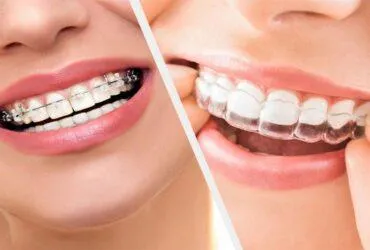
Braces vs Invisalign
Braces vs. Invisalign: Comparing Costs, Comfort, and Results
Braces vs. Invisalign: Which is Right for You?
Orthodontic treatment is a big decision, and choosing the right option for you can feel overwhelming. Two of the most popular ways to straighten teeth are traditional braces and Invisalign aligners. Both are effective, but they work differently and have unique advantages and disadvantages. Let's break them down:

How They Work:
Braces
Traditional braces consist of metal brackets that are glued to each tooth and connected by wires. The wires are tightened periodically to gradually move teeth into the desired position.
Invisalign
Invisalign uses a series of clear, custom-made plastic aligners. You wear each aligner for about one to two weeks, and as you switch to the next set, your teeth gradually shift.
Average Costs:
The cost of both treatments varies depending on the complexity of your case, your location, and your orthodontist. However, here's a general average:
Braces: $3,000 - $7,000.
Invisalign: $3,000 - $8,000.
Why Choose One Over the Other?
People choose between braces and Invisalign for several reasons:
Appearance: Many people prefer Invisalign because it is virtually invisible. Braces are more noticeable, and this may be a concern for adults or image-conscious teenagers.
Complexity of Correction: Braces are typically better for complex cases that require significant tooth movement, such as severe rotations, large gaps, or impacted teeth. Invisalign is more appropriate for mild to moderate alignment issues.
Discipline and Responsibility: Invisalign aligners are removable and require a high level of patient compliance. The aligners must be worn for 20-22 hours per day to be effective. This may not be ideal for younger patients who may not be as responsible. Braces, being fixed, eliminate this issue.
Comfort: Invisalign aligners are generally more comfortable than braces, which can cause discomfort and irritation to the mouth and gums.
Dietary Restrictions: Braces have some dietary restrictions as you need to avoid sticky, hard, or chewy foods that may damage your brackets and wires. Invisalign requires you to take out the aligners when you eat, allowing you to eat whatever you want.
Pros and Cons

Braces:
Pros:
Effective for correcting complex orthodontic issues.
No need to worry about compliance, since they are fixed to the teeth.
May be more affordable than Invisalign for some cases.
May be able to treat more complex issues.
Cons:
More noticeable than Invisalign.
Can cause discomfort and irritation.
Dietary restrictions are necessary.
Require more frequent visits to the orthodontist for adjustments.
May be more challenging to clean around.
Invisalign:

Pros:
Virtually invisible.
More comfortable than braces.
Removable for eating, drinking, and brushing.
Fewer visits to the orthodontist.
Easier to clean the teeth.
Cons:
Requires a high level of patient responsibility and compliance.
Not ideal for complex orthodontic cases.
May be more expensive than braces.
Can be prone to staining.
Can be lost or damaged easily.
Which One Is Right for You?
The best orthodontic treatment for you will depend on your specific needs, preferences, and budget. It is best to consult with an orthodontist to discuss your options and create a treatment plan that is customized for you.
If you have any other questions or would like more information, please feel free to ask!
